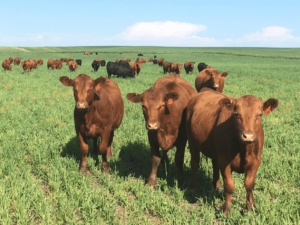
FARGO, N.D. (NDSU) – Managing infectious diseases in cattle herds involves all aspects of the beef cow-calf system.
The systems approach includes matching genetic selection to resources, meeting nutrition requirements, reducing environmental stress and the use of specific vaccine protocols.
That vaccine protocol is part management and part product/protocol selection, according to North Dakota State University Extension veterinarian and livestock stewardship specialist Gerald Stokka.
Here is advice for good management:
- Move cows to new calving grounds or move cows that have not calved to provide more space to decrease some of the risk associated with the buildup and spread of environmental pathogens to susceptible animals.
- Assess body condition scores (BCS) and change cow management to improve the opportunity for thin cows to re-breed in a timely fashion. Cows that are too thin (BCS of 4 or less) will need extra portions of high-quality feed to regain lost condition. Excellent spring grass growth can meet these needs, but dry conditions may require cows to be fed stored feed longer than normal this spring and early summer. Heifer calves that have been limit fed and were on restricted growth during the winter will need a higher-quality diet to begin cycling and conceive early in the breeding season.
- Have a veterinarian give bulls a complete breeding soundness and physical exam before the breeding season to assess their feet, legs and BCS. Mature bulls should be able to maintain weight during the winter on a hay diet and gain weight rapidly on good grass.
“Bulls should not be overly thin prior to breeding because young bulls may lose considerable weight during the breeding season,” says Janna Block, Extension livestock systems specialist at NDSU’s Hettinger Research Extension Center. “In addition, bulls should not be overly fat because of the potential for scrotal fat to reduce the testicles’ cooling capabilities in hot weather and subsequently reduce semen quality. All bulls also should have a semen evaluation before the breeding season.”
Product and vaccine protocol selection involves an assessment of the risk for certain diseases, and the efficacy and safety of specific products such as vaccines.
“This aspect of cattle ‘insurance’ must be done in consultation with your veterinarian,” Stokka says.
“Newborn calves receive immune protection through the nursing and absorption of the dam’s colostrum,” he notes. “Calves that are shortchanged in this process will be at a greater risk of sickness, death and loss of productivity, and vaccines cannot overcome this deficiency. However, vaccines can decrease the risk to the individual and to the group of specific diseases most common to the nursing calf.”
Here are conditions related to bacterial and viral infections that present some level of risk to young calves:
- Clostridial diseases, commonly called “blackleg” – The risk of this infection is difficult to assess. However, this organism lives in the soil and can cause severe illness and death in susceptible animals. The immune response vaccines for these diseases seem to provide excellent protection at a very economical price.
- Enteric conditions such as calf enterotoxemia and gut stasis – These conditions result in dehydration and an electrolyte imbalance, and can cause the appearance of bloat in young calves. One way to deal with this condition is to encourage cows and calves to pair up even during feeding time, which encourages regular nursing. Products that provide “insurance” are clostridium perfringens (enterotoxemia) vaccines given to cows, which then pass immunity to the calf through colostrum. Alternatively, enterotoxemia vaccines can be given to the calf at birth so the calf can develop an active immune response to reduce its susceptibility to this specific toxin-producing pathogen.
- Respiratory (summer pneumonia) conditions – These conditions typically occur in calves that are at least 4 weeks old. They may be related to viral and bacterial infections such as IBR (infectious bovine rhinotracheitis), BVD (bovine viral diarrhea), BRSV (bovine respiratory syncytial virus), Mannheimia, Histophilus, Pasteurella and Mycoplasma. However, deficiencies in passive immunity and environmental conditions such as cold, wet or extremely dry, dusty conditions and abrupt temperature changes increase the risk. Additionally, commingling and sorting procedures that occur at breeding times, artificial insemination and estrous synchronization programs, and even pasture movements can increase the risk of disease. Purchasing “insurance” vaccines and reducing the risk for respiratory conditions must be combined with attention to other risk factors. Consult your veterinarian about specific products and viral and bacterial vaccines.
- Pinkeye – This condition is one of the most frustrating to manage. It involves an infection of the cornea of the eye and is painful. Without intervention, it may result in a temporary or permanent loss of sight. Vaccines are available, but their efficacy and the reduction of risk are very difficult to evaluate.
- Footrot – This bacterial condition does not seem to cause outbreaks in young calves, but it occurs more often in bulls, yearling cattle and young cows. Without proper intervention and treatment, permanent lameness may result.
“Remember, not all cattle that are lame have footrot,” says Lisa Pederson, Extension livestock specialist at NDSU’s Central Grasslands Research Extension Center. “Other conditions that may cause lameness are cracked hooves, and knee and joint injuries.
The effectiveness of footrot vaccines is difficult to evaluate in these cases. The use of footrot vaccines may be targeted toward high-risk animals such as young bulls and heifers.
“An important aspect of the protocol portion of herd management is to do your very best to reduce the likelihood of disease pathogens having the opportunity to proliferate in herds,” Stokka says. “Protocol steps to reduce disease proliferation include segregating newly purchased animals from the rest of the herd for a period of time, conducting routine evaluations of the herd, having protocols in place for treatment of animals, rapidly identifying and treating sick animals, and ensuring that all animal-handling events are conducted in a calm, low-stress manner to the extent possible.”
